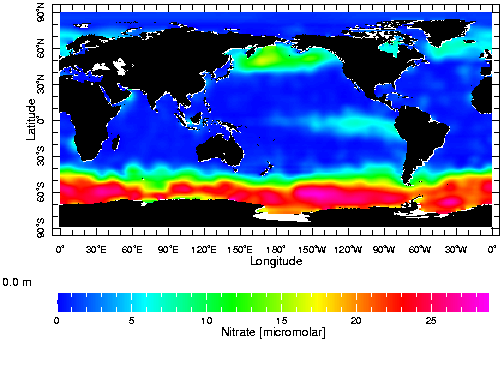|
|
 |
|
|
|
 |
| |
|
|
 |
The Oceans
Read more |
Iron in the oceans
Iron is the fourth most abundant chemical element in the Earth's crust, making up around 4% of the total mass. It is an essential micronutrient for all living species. The most important source of iron to the oceans is dust and this comes almost entirely from the desert areas of the Earth. There are large regions of the oceans where there are plenty of nitrogen and phosphorous containing nutrients but not many phytoplankton. These areas are far away from the deserts and it is assumed that lack of iron prevents phytoplankton growing here.
|
|
|
|
|
 |
Where does the iron in the oceans come from? |
 |
 |
|
1. NASA SeaWiFS satellite image of a dust storm off Africa, 26th February 2000. This massive storm enabled Saharan dust to be transported over 1000 miles into the Atlantic Ocean. This image was produced by the SeaWiFS project, NASA/GSFC and ORBIMAGE. Click on the picture for a better view (128 kb).
|
|
 |
The atmosphere is probably the largest source of iron to the oceans and this iron comes mainly from the wind erosion of soils to form dust. The dust mainly comes from arid and semi-arid desert regions, most of which are in the mid-latitudes of the Northern Hemisphere. The amount of dust produced by the deserts depends on how much it rains and on how strong the winds are. Highest dust concentrations are seen near the deserts and lowest amounts are seen in in the air above the Southern Ocean near Antarctica as this is as far away from the dusty deserts as is possible.
|
Dust inputs to the oceans
Large dust particles rapidly settle out of the atmosphere but particles with a diameter of less than 10 Ám (thats 0.00001 m) can travel great distances. Winds rapidly carry the particles hight in to the air, up to 5 km over the Atlantic and 8 km over the Pacific. It takes about one week for African dust from the Sahara to cross the Atlantic Ocean and two weeks for dust to travel from the Chinese deserts to the Central Pacific Ocean. The dust particles then either fall out of the air as dry particles or are scavenged by water drops and enter the oceans in rain.
|
 |
 |
 |
|
2. Advanced Very High Resolution Radiometer (AVHRR) images of particle transport in the atmosphere between June and August. These images show the major dust transport routes across the Atlantic and Indian Oceans. As they measure all particles in the air, they also show particles coming off southwest Africa from biomass burning and pollutants coming off the eastern coast of North America. Copyright American Geophysical Union. Click on the picture for a better view (151 kb).
|
|
|
Even though iron is very abundant in dust and lots of dust enters the oceans, iron concentrations are extremely low in seawater (generally less than 1 nmol L-1, thats <0.000000001 mol L-1!). We now know that the iron in dust occurs mainly as oxidised iron(III) complexes which are not very soluble in water. As dust is transported through clouds it encounters very acidic conditions which increase the solubility of the iron a bit. However, we still think that less than 2% of the iron entering seawater from the atmosphere is soluble and can be taken up by phytoplankton and used as a nutrient.
|
High Nitrate, Low Chlorophyll (HNLC) regions of the oceans
The major nutrients which control phytoplankton growth in the oceans are nitrate and phosphate and, to a lesser extent, silicate. In most oceans, phytoplankton grow until they have used up all of the nitrate or all of the phosphate, which ever runs out first. The subarctic Pacific, the equatorial Pacific and the Southern Ocean, however, all have plenty of these nutrients all year round but have low phytoplankton growth and corresponding low levels of chlorophyll, the photosynthetic pigment in plants. These regions are known as the HNLC regions of the oceans and make up about 20% of the total area of the ocean.
|
 |
 |
|
3. Map of annual average nitrate concentrations in the surface waters of the oceans. This image clearly shows the high levels of nitrate in the subarctic Pacific, the equatorial Pacific and the Southern Ocean. Data from the Levitus World Ocean Atlas 1994.
The scientist John Martin first suggested that it was a lack of iron in these HNLC ocean areas which prevented phytoplankton growing and scientific experiments conducted at sea confirmed this. Oceanographically these HNLC regions are all sites where the ocean circulation brings large amounts of deep water to the surface in a process known as upwelling. These deep waters contain high concentrations of the major nutrients and the waters should, in theory, be very biologically active. However, these regions are all far from the large deserts so not much dust (and therefore iron) enters the surface waters. Similar upwelling is seen north of 40 oN in the North Atlantic, but this ocean area isn't a HNLC region as it has large inputs of iron from Saharan dust.
About this page:
author: Dr. Lucinda Spokes - Environmental Sciences, University of East Anglia, Norwich - U.K.
scientific reviewer: Dr. Peter Croot - Institute for Marine Research, University of Kiel, Kiel - Germany.
last updated: 2003-10-01
|
|
 |
|







